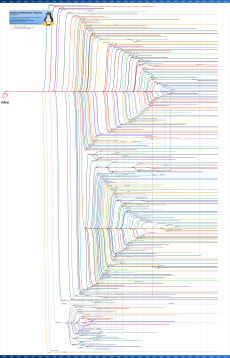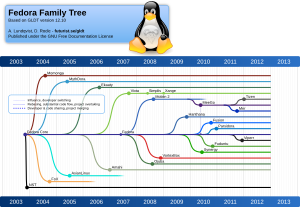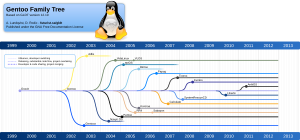List of Linux distributions facts for kids
This page tells you about different types of Linux operating systems. These are like different versions of a computer's main software. They are grouped by the main system or "package manager" they are based on. Think of a package manager as a tool that helps install and update software on your computer.
Contents
Debian-based Systems
Debian is a Linux system that focuses on free software. This means the software is open for anyone to use, change, and share. Debian works on many different types of computers. It and its related systems use a special type of software package called `.deb` and a tool called `dpkg` (or `apt`) to manage them.
Ubuntu and Its Family
Ubuntu is a popular Linux system based on Debian. It's designed to be easy to use and gets updated regularly. Ubuntu is used on both desktop computers and powerful servers. The name "Ubuntu" comes from an African idea about being kind and connected to others.
Official Ubuntu Versions
These versions of Ubuntu are also called "flavors." They install different sets of programs but share the same main software updates as regular Ubuntu. This means they can all run the same apps.
| Distribution | What it's for |
|---|---|
| Edubuntu | This version was made for schools. It helped students and teachers use Linux for learning. |
| Kubuntu | Kubuntu uses a different look and feel called KDE instead of the usual Ubuntu desktop. |
| Lubuntu | Lubuntu is a "lighter" version of Ubuntu. It uses less power and works well on older or slower computers. |
| Ubuntu Budgie | This version uses a modern and stylish desktop called Budgie. |
| Ubuntu MATE | Ubuntu MATE uses a desktop that looks and feels like older computer systems, making it simple to use. |
| Ubuntu Server | This version is made for powerful computers called servers. Servers handle things like email, websites, and shared files. |
| Ubuntu Studio | Ubuntu Studio is for creative people. It has many free tools for making music, videos, and graphics. |
| Xubuntu | Xubuntu is another lightweight version of Ubuntu. It's great for computers that aren't super powerful. |
Older Ubuntu Versions
These are some Ubuntu versions that are no longer actively developed or have been combined into the main Ubuntu system.
| Distribution | What it was for |
|---|---|
| Mythbuntu | This was for setting up a media center to record TV and play media. |
| Ubuntu GNOME | This version used the GNOME Shell desktop. Now, the main Ubuntu uses GNOME by default. |
| Ubuntu Touch | Ubuntu Touch was made for devices with touchscreens, like phones and tablets. |
Other Ubuntu Systems
These are versions of Ubuntu made by different groups, not directly by the official Ubuntu team. They often have special goals.
| Distribution | What it's for |
|---|---|
| BackBox | BackBox is for testing computer security. It helps experts find weaknesses in systems. |
| Bodhi Linux | This system is for users who want a very basic setup. It lets them add only the software they need. |
| elementary OS | This system focuses on being easy to use for people who aren't tech experts. |
| Linux Lite | Linux Lite helps people who are used to Microsoft Windows try out Linux. It's simple and fast. |
| Linux Mint | Linux Mint is very popular for desktop users. It aims to be super user-friendly. |
| MX Linux | MX Linux is a stable and fast system. It's known for being easy to set up and use. |
| Pop! OS | Pop! OS is made by a computer company called System76. It's often used on their own computers. |
| Zorin OS | Zorin OS is designed to look like Microsoft Windows or macOS. This makes it easier for new Linux users. |
Knoppix and Its Family
Knoppix is based on Debian. It's a "live" system, meaning you can run it directly from a CD or USB stick without installing it. It's great for trying out Linux or fixing computer problems.
| Distribution | What it's for |
|---|---|
| ... Small Linux | This tiny Linux system is made for very old computers. It doesn't need much memory. |
Kali Linux and Its Family
BackTrack was a system for testing computer security. In 2013, the team rebuilt it as Kali Linux, based on Debian.
| Distribution | What it's for |
|---|---|
| Kali Linux | Kali Linux is a powerful system for computer security experts. It helps them test how secure systems are. |
| Kali NetHunter | This is a special mobile version of Kali Linux for phones. |
Other Debian Systems
Here are some other Linux systems that are based on Debian.
| Distribution | What it's for |
|---|---|
| antiX | antiX is a lightweight system that works well on older computers. |
| Deepin | Deepin is a Chinese Linux system known for its beautiful and user-friendly desktop. |
| PureOS | PureOS focuses on privacy and security. It's designed to keep your information safe. |
| Raspberry Pi OS | This is the official system for the tiny, low-cost Raspberry Pi computers. |
| The Amnesic Incognito Live System (TAILS) | Tails is a special system that helps you stay private and anonymous online. All your internet traffic goes through a network called Tor. |
Pacman-based Systems
Pacman is a tool that helps install and manage software. It's mainly used by Arch Linux and systems based on it.
Arch Linux and Its Family
Arch Linux is a system for experienced users. It's designed to be simple and lets you build your system exactly how you want it. It always has the newest software.
| Distribution | What it's for |
|---|---|
| Arch Linux ARM | This is Arch Linux made for computers with ARM processors, like some small devices. |
| Asahi Linux | Asahi Linux is a project to make Linux work on Apple's newer Mac computers. |
| BlackArch | BlackArch is another system focused on cybersecurity and penetration testing. |
| EndeavourOS | EndeavourOS is a popular system that makes it easier to install Arch Linux with a graphical installer. |
| Manjaro | Manjaro is based on Arch Linux but is much easier for new users. It comes with different desktop styles. |
| SteamOS | SteamOS is a gaming-focused system made by Valve. It's used on the Steam Deck handheld gaming device. |
Other Pacman Systems
| Distribution | What it's for |
|---|---|
| KaOS | KaOS is a system that focuses on the KDE Plasma desktop and the Qt software tools. |
RPM-based Systems
Red Hat Linux and SUSE Linux were the first big systems to use the `.rpm` software package format. Today, many systems still use `.rpm`. These original systems later split into free community versions and paid business versions.
Fedora and Its Family
Fedora is a community-supported system. It aims to have the newest software while keeping everything free and open-source.
Red Hat Enterprise Linux (RHEL) Family
Red Hat Enterprise Linux is a paid, business-focused Linux system. Many other systems are built to be compatible with it.
| Distribution | What it's for |
|---|---|
| AlmaLinux | AlmaLinux is a free system that works just like Red Hat Enterprise Linux. It's managed by a community. |
| Oracle Linux | This system is supported by Oracle. It's also designed to be fully compatible with Red Hat Enterprise Linux. |
| Rocky Linux | Rocky Linux is another free system that aims to be compatible with Red Hat Enterprise Linux. |
Other Fedora Systems
| Distribution | What it's for |
|---|---|
| Amazon Linux 2 | This system is made by Amazon for use with their cloud computing services. |
| CentOS Stream | CentOS Stream is a community system that is closely related to Red Hat Enterprise Linux. |
| Qubes OS | Qubes OS focuses on security for desktop users. It uses different virtual machines to keep things safe. |
openSUSE and Its Family
openSUSE is a Linux system developed by a community and supported by SUSE. It makes sure all its standard software is free and open-source. SUSE's business products are based on openSUSE.
| Distribution | What it's for |
|---|---|
| GeckoLinux | GeckoLinux focuses on being polished and easy to use right away. |
| SUSE Linux Enterprise | This is SUSE's paid version for businesses, available for both desktops and servers. |
Mandriva and Its Family
Mandriva Linux was an open-source system that stopped being developed in 2011. It was known for being easy for new users. Its developers later started new projects.
| Distribution | What it's for |
|---|---|
| Mageia | Mageia is a community Linux system that started when Mandriva Linux stopped its free versions. |
| OpenMandriva | OpenMandriva is another system that came from Mandriva Linux. |
Other RPM Systems
| Distribution | What it's for |
|---|---|
| PCLinuxOS | PCLinuxOS is a "rolling release" system, meaning it gets continuous updates instead of big new versions. |
Gentoo-based Systems
Gentoo is a system designed for highly optimized and frequently updated software. Systems based on Gentoo use a special tool called Portage to manage software.
| Distribution | What it's for |
|---|---|
| ChromeOS | This is Google's system used on Chromebooks. It's mostly based on the internet and uses the Chrome browser. |
| ChromiumOS | This is the free and open-source version of ChromeOS. |
| Pentoo | Pentoo is a "Live CD" system for testing computer security. |
Slackware-based Systems
Slackware is a very flexible system. It's known for being reliable and easy to maintain, but it's generally for more experienced users.
| Distribution | What it's for |
|---|---|
| Absolute Linux | Absolute Linux is a lightweight system based on Slackware. |
| Porteus | Porteus is a small and fast Linux system that you can carry on a USB drive. |
| Salix OS | Salix is a complete Linux system that works well with Slackware. |
| Slax | Slax is a small "live CD" system. It's designed to run from a CD or USB drive and is great for general use on less powerful computers. |
| VectorLinux | VectorLinux is a lightweight system that's easy to use, even for new users. It's good for older computers. |
Android-based Systems
Android is a mobile system made by Google. It's based on a special version of the Linux kernel and is mostly for phones and tablets.
| Distribution | What it's for |
|---|---|
| /e/ | /e/ is an Android-based system that focuses on privacy. |
| Android-x86 | This project lets you run Android on regular computers with x86 processors. |
| CalyxOS | CalyxOS is an Android system that aims to improve privacy and security on smartphones. |
| LineageOS | LineageOS is a popular open-source Android system for phones and tablets. |
| Remix OS | Remix OS allowed computer users to run Android apps on their PCs. |
Other Systems
These are some other Linux systems that don't fit into the categories above.
| Distribution | What it's for |
|---|---|
| Alpine Linux | Alpine Linux is a small and secure system. It's often used for servers and mobile devices. |
| Clear Linux OS | This system is made by Intel and is optimized for Intel processors to be very fast and secure. |
| OpenWrt | OpenWrt is a system for routers and firewalls. It lets you control your network devices. |
| Puppy Linux | Puppy Linux is a very small system that runs well on old computers, even with little memory. |
| Sailfish OS | Sailfish OS is a Linux-based mobile system developed by a Finnish company called Jolla. |
| Solus | Solus is a desktop Linux system with different desktop styles and its own software manager. |
| Tiny Core Linux | Tiny Core Linux is an extremely small system (around 10 MB) that provides a very basic setup. |
| Tizen | Tizen is a Linux-based mobile system supported by the Linux Foundation and used by Samsung. |
| Void Linux | Void Linux is an independent system that uses a different way to manage software and startup. |
Historical Systems
These are some of the very first Linux systems that were created.
| Distribution | What it was for |
|---|---|
| MCC Interim Linux | This was likely the very first Linux system, made in 1992. |
| Softlanding Linux System | This was one of the earliest Linux systems, and Slackware was originally based on it. |
|
See also
 In Spanish: Anexo:Distribuciones Linux para niños
In Spanish: Anexo:Distribuciones Linux para niños
- Comparison of Linux distributions
- DistroWatch
- List of live CDs









